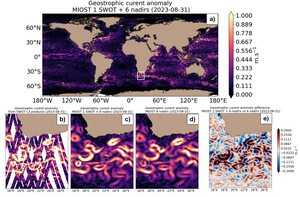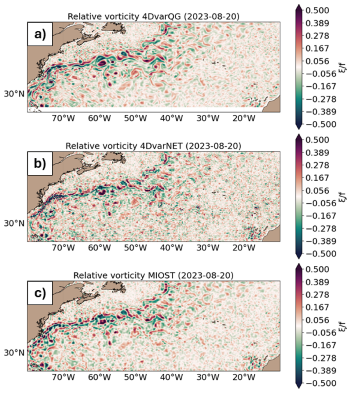Experimental multimission gridded L4 sea level heights and velocities with SWOT

Type of dataset: SSALTO/DUACS Mutlimission Experimental Level-4 maps, computed with SWOT Level-3 products (using both KaRIn and nadir instruments).
Digital Object Identifiers (DOIs): For v0.3 and v1.0: 10.24400/527896/A01-2024.007 - more metadata
Condition of access: Users should keep in mind that these products are experimental products. Notably, they are not produced on an operational basis. These products are available free of charge for any purpose (scientific, operational, commercial, etc.) as stated in the licence agreement.
Contents: multimission sea surface heights and derived geostrophic velocity computed from nadirs and SWOT altimetry data, and in using the Multiscale Interpolation Ocean Science Topography (MIOST, Ubelmann et al., 2021), the 4DvarQG mapping technique (Le Guillou et al., 2021, https://github.com/leguillf/MASSH), and the 4DvarNET mapping algorithm (Fablet et al., 2021, Beauchamp et al., 2023, github.com/CIA-Oceanix/4dvarnet-core)
Use: regional studies, ocean variability (mesoscale circulation,...).
Description: These gridded products are produced from the along-track (or Level-3) SEA LEVEL products (DOI: doi.org/10.48670/moi-00147) delivered by the Copernicus Marine Service (CMEMS, marine.copernicus.eu) for satellites SARAL/AltiKa, Cryosat-2, HaiYang-2B, Jason-3, Copernicus Sentinel-3A&B, Sentinel 6A, SWOT nadir, and SWOT Level-3 KaRIn sea level products (DOI: https://doi.org/10.24400/527896/A01-2023.018).
Three mapping algorithms are proposed:
- the MIOST approach which give the global SSH solutions: the MIOST method is able of accounting for various modes of variability of the ocean surface topography (e.g., geostrophic, barotrope, equatorial waves dynamic …) by constructing several independent components within an assumed covariance model.
- the 4DvarNET approach for the regional SSH solutions: the 4DvarNET mapping algorithm is a data-driven approach combining a data assimilation scheme associated with a deep learning framework.
- 4DvarQG approach for the regional SSH solutions: the 4DvarQG mapping technique integrates a 4-Dimensional variational (4DVAR) scheme with a Quasi-Geostrophic (QG) model.
Geographic coverage: global (80°S-0°W/90°N-360°E for MIOST) & regional (25°N-80°W/50°N-10°W for 4DvarNET and 4DvarQG)
Citation: When using the SSALTO/DUACS experimental products, please cite: "These products were processed by SSALTO/DUACS and distributed by AVISO (https://www.aviso.altimetry.fr) supported by CNES (version X.X). DOI: 10.24400/527896/a01-2004.007”
Resources:
- User handbook: SSALTO/DUACS experimental products handbook: Gridded Sea Level Height and geostrophic velocities computed with SWOT Level-3 products (using both KaRIn and nadir instruments).
- Ballarotta, M., Ubelmann, C., Bellemin-Laponnaz, V., Le Guillou, F., Meda, G., Anadon, C., Laloue, A., Delepoulle, A., Faugère, Y., Pujol, M.-I., Fablet, R., and Dibarboure, G.: Integrating wide swath altimetry data into Level-4 multi-mission maps, EGUsphere [preprint], doi.org/10.5194/egusphere-2024-2345, 2024.
- Beauchamp, M., Febvre, Q., Georgenthum, H., and Fablet, R.: 4DVarNet-SSH: end-to-end learning of variational interpolation schemes for nadir and wide-swath satellite altimetry, Geosci. Model Dev., 16, 2119–2147, https://doi.org/10.5194/gmd-16-2119-2023, 2023.
- Fablet, R., Beauchamp, M., Drumetz, L., and Rousseau, F.: Joint Interpolation and Representation Learning for Irregularly Sampled Satellite-Derived Geophysical Fields, Front. Appl. Math. Stat., 7, 655224, https://doi.org/10.3389/fams.2021.655224, 2021
- Le Guillou, F., Metref, S., Cosme, E., Ubelmann, C., Ballarotta, M. Le Sommer, J. Verron, J.: Mapping Altimetry in the Forthcoming SWOT Era by Back-and-Forth Nudging a One-Layer Quasigeostrophic Model, J. Atmos. Oceanic Technol., 38, 697–710, https://doi.org/10.1175/JTECH-D-20-0104.1, 2021
- Ubelmann, C., Dibarboure, G., Gaultier, L., Ponte, A., Ardhuin, F., Ballarotta, M., & Faugère, Y.: Reconstructing ocean surface current combining altimetry and future spaceborne Doppler data. Journal of Geophysical Research: Oceans, 126, e2020JC016560. https://doi.org/10.1029/2020JC016560, 2021
Delayed-time gridded Experimental product with SWOT
| Satellite | Version | Mapping Method | Area | Type | Authenticated access service | Data period | File weight | Handbook |
|---|---|---|---|---|---|---|---|---|
| Merged | v0.3 | MIOST 4DvarNET 4DvarQG | global | gridded | please refer to MY AVISO+ and select the product "Ssalto/Duacs Experimental products: along-track and gridded Sea Level Heights and velocities" | 2023/03/28-2023/07/11 (calval) 2023/07/10-2023/11/30 (science) | 42 MB (miost) and 1.3 MB (others) per file | product user manual |
| v1.0 | 2023/03/28-2023/07/10 (calval) 2023/07/11-2024/07/01 (science) |





